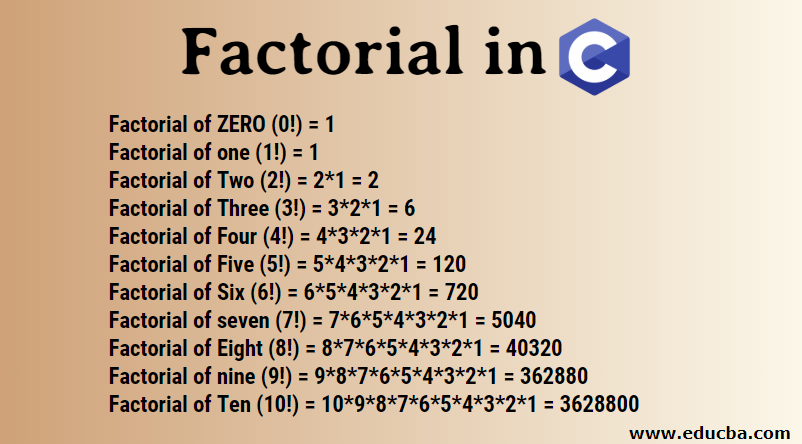Updated March 16, 2023

Introduction to Factorial in C program
The following article, Factorial in C Program, provides an outline for C’s topmost factorial methods. The symbol for factorial is denoted by using this! ‘ sign. For instance, the number 6 factorial is referred to as 6!. Number factorial is described as the product “of the number, and all the entries are smaller than zero and negative.” For factorial concepts, natural numbers (non-negative entities) higher than zero are used.
Let us see some examples to understand how factorial is calculated. Below we have calculated factorial for numbers 1 to 10.
- Factorial of ZERO (0!) = 1
- Factorial of one (1!) = 1
- Factorial of Two (2!) = 2*1 = 2
- Factorial of Three (3!) = 3*2*1 = 6
- Factorial of Four (4!) = 4*3*2*1 = 24
- Factorial of Five (5!) = 5*4*3*2*1 = 120
- Factorial of Six (6!) = 6*5*4*3*2*1 = 720
- Factorial of seven (7!) = 7*6*5*4*3*2*1 = 5040
- Factorial of Eight (8!) = 8*7*6*5*4*3*2*1 = 40320
- Factorial of nine (9!) = 9*8*7*6*5*4*3*2*1 = 362880
- Factorial of Ten (10!) = 10*9*8*7*6*5*4*3*2*1 = 3628800
Below is the common mathematical formula for determining the numbers ‘ n ‘ factor.
n! = n ( n – 1)( n – 2)( n – 3) ……
Examples of Factorial in C by Using various method
In this section, we are going to discuss how factorial is calculated in the C program using different methods.
Example #1 – Using the if-else statement
If the statement is evaluated in an if-else statement, if the statement in it is true, it will give the output. If the statement in if the condition is not true, it transfers the control to the else statement and else statement is being executed. Let us see how we can calculate factorial using the if-else statement.
Code
#include<stdio.h>
#include<conio.h>
int main()
{
int number, i, fact = 1;
printf("Enter the positive number to find the factorial: ");
scanf("%d",&number);
// if number is negative show the error
if (number < 0)
printf("Error! You have entered negative number and Factorial for negative number does not exist.");
else
{
for(i = 1; i <= number; ++i)
{
fact *= i; // factorial = factorial*i;
}
printf("Factorial of the given number %d is %llu", number, fact);
}
return 0;
}Explanation of the above code
In the above example, we have initialized three variables number, i.e. I and fact. Then scan function is used to allow a user to enter the number by their wish. If the condition first checks if the given number is negative or not, if it is negative, it will execute if the statement and throw the error and stop the program.
Output for the negative number:
And if the given number is positive, it will transfer control to else statement and condition are given in the else statement is executed, and it will calculate the factorial for a given number. The output for the positive number is as follows.
Output for the positive number:
Example #2 – Using For loop
In the For loop, the first initialization step is executed and only once in the whole program. In this step, you can initialize and declare variables for the code. After that condition is evaluated. If the condition is true, then it will execute the code inside the block of For loop. If the condition is false, it will jump to the code after the For loop without executing the For loop code.
After the For loop, the increment statement will be executed. After that, again, the condition will be checked. Loop will get executed if the condition is true, and the loop will repeat itself, i.e. the body of the loop, an increment statement, and condition. The loop ends when the condition is false.
Code
#include<conio.h>
#include<stdio.h>
int main()
{
int i, fact = 1, number;
printf("Enter the number to find the factorial: ");
scanf("%d", &number);
for(i = 1; i <= number; i++){
fact = fact * i;
}
printf("Factorial of the given number %d is %llu", number, fact);
return 0;
}Output:
Explanation of the above program
In this program, we have initialized the variables I, fact and number. When the condition of for loop. The scan function is used to allow a user to enter the number by their wish. After that, For loop will work as explained above.
Example #3 – Using recursion method
Recursion is a method where, for instance, the feature itself is called in the software factory function below. You first need to convey its answer in the recursive form to resolve an issue via resource.
Code
#include<stdio.h>
#include<conio.h>
factorial(int);
int main()
{
int number, fact;
printf("Enter the number to find the factorial:");
scanf("%d", &number);
if(number < 0)
printf("Negative integer factorial is not described.\n");
else
{
fact = factorial(number);
printf("Factorial of the given number %d is %llu ", number, fact);
}
return 0;
}
factorial(int number)
{
if (number == 0)
return 1;
else
return(number * factorial(number - 1));
}Output:
Example #4 – Using function
Code
#include <stdio.h>
#include<conio.h>
factorial(int);
int main()
{
int number, fact = 1;
printf("Enter the number to find the factorial: ");
scanf("%d", &number);
printf("Factorial of the given number %d is %llu", number, factorial(number));
return 0;
}
factorial(int n)
{
int c, result = 1;
for (c = 1; c <= n; c++)
result = result * c;
return result;
}Output:
Conclusion
In this article, we have seen how to calculate the factorial of a number in C by using conditional statements and functions. I hope this article will help you in understanding the working of factorial in C.
Recommended Articles
This has been a guide to Factorial in C. Here we discuss factorial for numbers 1 to 10, examples of factorial in C by using the various method, formula for “n factor” with codes and outputs. You can also go through our given articles to learn more-





